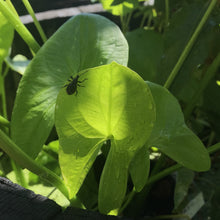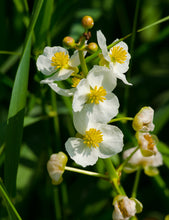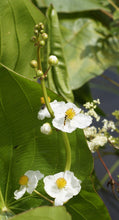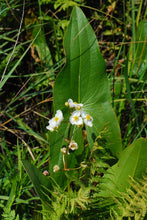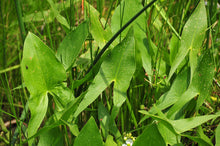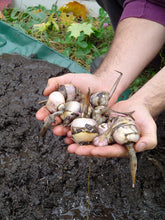
Sagittaria latifolia
Wapato is a colony-forming, aquatic perennial typically found improving the water quality in swamps and ponds. It flaunts attractive, arrow-shaped leaves and, in mid-late summer, showy white and yellow flowers on stalks up to 3' high. In mud, the rhizomes produce starchy tubers that are an important food source for wildlife and humans, making Wapato a culturally significant plant for indigenous communities for tens of thousands of years.
- Plant type/canopy layer: deciduous perennial herbaceous plant
- Size at maturity: 0-3' high, 0-1' wide
- Light requirements: full sun to part sun
- Moisture requirements: seasonally to perennially wet soil
- Bloom time: July - September
- Growth rate/ease: fast growing, easy to grow
- Wildlife support: overall plant attracts and supports beneficial and other pest eating insects and is a caterpillar host plant; flowers are a nectar source for hummingbirds, adult butterflies and a nectar/pollen source for native bees and other insect pollinators; leaves are a larval food source for native butterflies and moths; tubers are utilized by 15 different waterbirds and muskrats, which is how it gets a well-earned nickname "duck potatoes''.
- Native habitat/range: locally common along the edges of streams and lakes, pools, ditches and marshes at low elevations, 0–300 ft, across the Pacific Northwest. Portland Plant List - yes.
- Special features & uses: edible; highly significant to some indigenous cultures; landscape uses include aquatic gardens, raingardens and bioswales where it provides erosion control and water quality improvements
Gardening with Wapato: This plant is an attractive and pollinator-friendly addition to wetlands, ponds, and water features. It requires a significant amount of moisture and grows best in full sun or light shade. When happy, Wapato will spread vigorously via rhizomes and runners.
Photo Credit 1: Nikkie West
Photo Credit 2 & 4: "Arrowhead (Sagittaria latifolia)" by wackybadger is licensed under CC BY-SA 2.0
Photo Credit 3: "Sagittaria latifolia Willd." by urjsa is licensed under CC BY-SA 2.0
Photo Credit 5: "Arrowhead (Sagittaria latifolia) on Lacreek NWR 01" by USFWS Mountain Prairie is licensed under CC BY 2.0
Photo Credit 6: "arrowhead Sagittaria latifolia" by eric.toensmeier is licensed under CC BY 2.0






